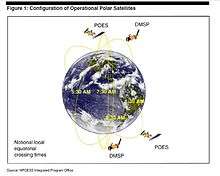Polar Operational Environmental Satellites
The Polar-orbiting Operational Environmental Satellite (POES) project operates a constellation of weather satellites in polar orbits around the Earth. It is a joint effort between the National Oceanic and Atmospheric Administration (NOAA) and the European Organisation for the Exploitation of Meteorological Satellites (EUMETSAT).[1] Spacecraft for the project are provided by NASA and the European Space Agency. NASA's Goddard Space Flight Center oversees the manufacture, integration and test of the NASA-provided TIROS satellites.[2] On-orbit satellite operation of these is performed by NOAA's Office of Satellite and Product Operations (OSPO).[3] The POES constellation also includes an ESA-provided MetOp satellite operated by EUMETSAT.
Daily global coverage

Each POES satellite completes roughly 14.1 orbits per day. Since the number of orbits per day is not an integer, the ground tracks do not repeat on a daily basis. The systems includes both morning and afternoon satellites which provide global coverage four times daily.[3]
Applications
Data from the POES satellites support a broad range of environmental monitoring applications including weather analysis and forecasting, climate research and prediction, global sea surface temperature measurements, atmospheric soundings of temperature and humidity, ocean dynamics research, volcanic eruption monitoring, forest fire detection, global vegetation analysis, search and rescue, and many other applications.[3]
Recent Launches
- MetOp-B - Launched 17 September 2012 from Baikonur Cosmodrome, Kazakhstan [4]
- NOAA-19 - Launched 6 February 2009 from Vandenberg Air Force Base, United States
- MetOp-A - Launched 19 October 2006 from Baikonur Cosmodrome, Kazakhstan
- NOAA-18 - Launched 20 May 2005 from Vandenberg Air Force Base, USA
- NOAA-17 - Launched 24 June 2002 from Vandenberg Air Force Base, USA
See also
References
- ↑ "EUMETSAT Polar System - Programme Background". EUMETSAT.
- ↑ "POES Project". NASA.
- 1 2 3 "Polar Orbiting Satellites". NOAA.
- ↑ "MetOp-B Launches with NASA Goddard-Developed Instruments."NASA. Retrieved: 21 June 2012.